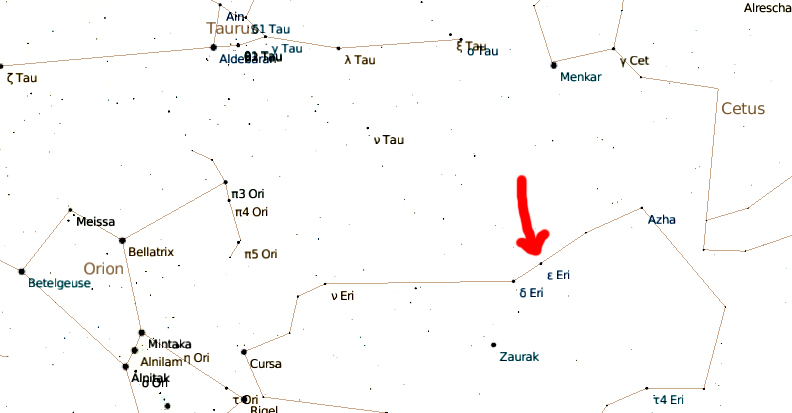 November-December Sky
November-December Sky
A guide for what’s coming up this month. I tried to include a fact and a lesser-known story for each object. I didn’t completely succeed. This guide is written to give hints to people who already know approximately what they’re looking at. For a good beginner’s guide to the sky, try StarDate, Sky and Telescope’s Stargazing Basics, or Sky and Telescope’s links to lots of beginning topics. (Or, if you know a better beginning stargazing site, put a link to it in a comment below!
New Constellations
ORION – The Hunter
SCIENCE: Don’t miss M42 – The Orion Nebula. When looking at the constellation, it’s where Orion’s sword is hanging from his belt. It’s a star-forming nebula made of gas and dust.
MYTH:The Bororo Indians of Brazil see a fearsome caiman in the stars of Orion. The Black Caiman of the Amazon is one of the largest types of alligators, and one of the few that poses a danger to humans. Sadly for the Black Caiman, we pose more of a danger to it: it has become an endangered species due to human hunting of its skin.
TAURUS – The Bull
SCIENCE: We’ve got two open clusters in Taurus – The Pleiades (in his shoulder) and the Hyades (the “V” shaped head of the bull. Open clusters are a small collection of stars that are actually gravitationally bound to each other. They tend to be young, newly-formed stars that are slowly moving apart from each other.
I love to mention that the Pleiades are my favorite deep sky object in the night sky – because they look different every night. Depending on the weather and your eyes, you might see a smudge, 4 stars, 6 stars, or even 10. With binoculars you’ll see dozens of stars. With a telescope you’ll see hundreds. It’s a great gateway into astronomy.
MYTH: Taurus is Zeus – in the bull form he used to conquer Europa. A slightly more family-friendly version of the story has Orion fighting Taurus the bull – and the Pleiades are a wound where Orion has stabbed him.
GEMINI – The Twins
SCIENCE: Castor and Pollux are the “head” stars of the twins. Castor is a septuplet star – three pairs of stars orbiting a common center of gravity. Yii! Six!
MYTH: India also considers these stars twins, they are called Aswins, the twin horseman associated with the dawn.
PISCES – The Fish
SCIENCE: I find Pisces by starting with the circle at the top. It doubles as Pegasus’s wings, although it is officially part of Pisces.
MYTH: The only way I can make heads or tails of this constellation is to see it as two fish on an upside-down fishing line.
CETUS – The Sea Monster
SCIENCE: As it is far out of the plane of the Milky Way, it is easier to see other galaxies in this area of the sky with a good telescope, though none of them are naked-eye visible.
MYTH: Cetus is part of the giant Andromeda/Cassie/Perseus/Cepheus/Pegasus mythology.
AQUARIUS – The Water Bearer
SCIENCE: There are a few clusters and nebulae in Aquarius, but the one that I find most beautiful is the Helix nebula. It’s a planetary nebula – an exploded envelope of gas around a star that went supernova many, many years ago. Do not confuse it with the Ring Nebula – it looks similar, and is the same type of nebula.
MYTH: Aquarius is the Water-bearer. This is also the constellation referred to in the phrase “Age of Aquarius” – but that’s of astrological significance, which I can’t speak to.
“Tiny” Guys
Going for the Gold? Here’s this month’s itty-bittys.
SCUTUM – The Shield
CAMELOPARDALIS– The Giraffe
SCULPTOR – A Sculptor’s Studio
ERIDANUS – The River
RECENT SCIENCE: Epsilon Eridani (ε Eri, a star in Eridanus) is a Sun-like star, AND we’ve detected two debris belts (like our Asteroid Belt and Kuiper Belt) around it. Beyond that there are at least two planets there.
TRIVIA: ε Eri is a very popular location in science fiction. In this case, I recommend the Wikipedia article. Notably – Babylon 5 is located at ε Eri. I thought I had been told that Vulcan orbited ε Eri, but I can’t find official confirmation of that. Vulcan is supposedly 16 lightyears away – ε Eri is 10 lightyears away.
TRIANGULUM – The Triangle
ARIES – The Ram
LYNX – The Lynx
LACERTA – The Lizard
EQUULEUS – The Little Horse
SAGITTA – The Arrow
VULPECULA – The Fox
Returning Constellations
ANDROMEDA – Princess Andromeda
PEGASUS – The Winged Horse
CEPHEUS – King Cepheus
PERSEUS – Perseus
DELPHINUS – The Dolphin
AQUILA – The Eagle
CYGNUS – The Swan or the Northern Cross
LYRA – The Harp
URSA MAJOR – The Great Bear
URSA MINOR – The Little Bear
CASSIOPEIA – The Queen
Happy Sky Viewing!
Where’d I get my Info?
My memory, and Zeta Strickland










According to this article, Vulcan is 40 Eridani A. So, same constellation, but different star.
Also, I totally misread “scutum” the first time. But since I expect this is meant to be a family-friendly blog, I won’t elaborate any further.
Thanks for the link Hannah that’s one more data point. Universe Today says Epsilon Eridani, AstroBio.net says 40 Eridani A … startrek.com says nothing, and neither does the fansite/wiki memory-alpha.org.
Has anyone seen an episode where they mention what star Vulcan’s around?